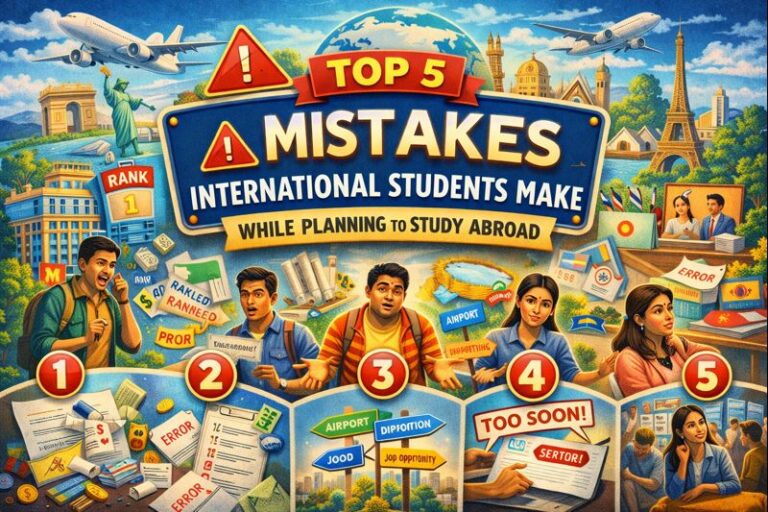For most families, the calculus behind “why study in Dubai” starts with brand, cost, and career upside.
In the last academic year alone, Dubai’s private-sector universities enrolled 42,026 students across 41 institutions, the city’s highest tally ever, with international enrolments jumping 29% year-on-year.
Add a resident population that is more than 85% expatriate, and the classroom you walk into mirrors the global teams you hope to join after graduation.
Layer on the five-year Green Visa pathway for high-achieving graduates, tax-free starting salaries, and a logistics hub that keeps two-thirds of the planet within an eight-hour flight, and Dubai moves from “interesting option” to “strategic choice.”
Below, we unpack the top reasons to study in Dubai, drill into costs, universities, work options, and quality-of-life metrics.
We begin by mapping the macro forces that make Dubai a magnet for talent, then get into the universities themselves, the cultural immersion that shapes students, and the financial realities on the ground.
Note: If you’re thinking about studying in Dubai, finding the right university and securing affordable funding are key steps. GradRight’s university search platform can simplify this process by offering personalized recommendations across thousands of programs and top UAE institutions. It matches your academic background, career goals, and budget to help you shortlist universities that align with your ambitions.
Once you’ve identified your preferred universities, GradRight’s loan search platform connects you with over 15 trusted lenders, including Indian banks and NBFCs, so you can compare education loan offers easily. With zero paperwork, no cosigner needed options, and expert support to negotiate better interest rates, the platform helps you secure the best financing terms quickly and hassle-free.
With GradRight’s tools, you can confidently plan your study journey in Dubai—balancing brand value, cost, and career prospects.
Now, let’s explore why Dubai has become a top choice for international students.
Why Dubai is a leading destination for international students
Before you pick a campus, zoom out and ask a bigger question: why study in Dubai at all?
The answer sits at the intersection of numbers, policy, and lifestyle. Let’s look at some of the reasons.
Instantly Global Classrooms
85% of the city’s 3.6 million residents are expatriates, so you train every day in the cross-cultural skills employers screen for.
Policy Built For Talent
KHDA’s quality audits give you a transparent programme scorecard, while the five-year Green Visa lets high-achieving graduates stay without a corporate sponsor, removing the post-study limbo common elsewhere.
Sector Momentum
Overall, private-sector enrolment rose another 12% in 2024 and hasn’t slowed, signalling sustained demand and investment.
Dedicated Education Zones
Dubai International Academic City alone aggregates 27 universities and 150+ nationalities under one student visa process, giving you scale without bureaucratic drag.
Together, these data points answer the core query, why Dubai is a popular destination for students, in concrete terms, like stable growth, clear visa paths, and a ready-made global network.
Those advantages matter only if the universities themselves deliver world-class credentials. Let’s look at the campuses anchoring Dubai’s academic scene.
World-class educational institutions in Dubai
Dubai doesn’t make you pick between an “international” badge and local industry traction, you get both, often on the same metro line.
Branch campuses import British, Australian, and the USA curricula, while home-grown universities climb the global rankings on the strength of research that plugs directly into the emirate’s tech-free zones.
American University in Dubai (AUD)
Dubai Media City puts AUD’s classrooms a lift-ride from regional media networks and tech labs.
The school holds dual accreditation (UAE-CAA and U.S. SACSCOC) and caps most classes at 25–30 students, so teaching stays hands-on even in popular majors such as business and engineering.
It also reports a 91% job-placement rate within a year of graduation, the best published figure in the emirate.
Quick facts:
- Tuition (full-load UG): ₹23.9 lakhs (AED 103,030)
- Rank: QS 2025 band #621–630
- Key scholarship: Senior Scholarship waives 25%–100% of tuition for a 3.5+ CGPA
- Typical stipend for part-time roles: ~AED 2,000 / month (₹46k) with firms in Dubai Silicon Oasis
- Student visa fee: ≈ AED 3,000/yr (₹70k)
University of Dubai (UD)
Set up by the Dubai Chamber of Commerce, UD was built to plug talent straight into the city’s ports, courts, and fintech labs.
All business programmes are AACSB-accredited, and engineering courses run joint labs with local utilities. Small total enrolment is about 1,000 students, which means quick faculty access and easy placement into Chamber-member firms for summer work. The career centre logs an 85% employment rate within six months of graduation.
Quick facts:
- Tuition (30-credit BBA year): ₹13.5 lakhs (AED 58,000), pay-per-course at AED 5,800
- Rank: QS 2025 band #851–900
- Fee relief: Merit or sibling discounts up to 50%, AED 2,500 (₹58k) referral discount
- Guaranteed internships: arranged through the Chamber, common hosts include DP-World’s Jebel Ali Port and DIFC fintech labs
- Student visa fee: ≈ AED 3,000/yr (₹70k)
Heriot-Watt University Dubai
Dubai follows the same syllabus that ranks the Edinburgh parent at QS #256.
A 2 + 2 pathway lets you finish in Scotland without reapplying for a UK visa, saving about ₹3 lakhs in paperwork and NHS charges. Final-year engineering teams test materials for the emirate’s record-size 3D-printed buildings.
Quick facts:
- Tuition (most UG programmes): ₹14.4 – 16.2 lakhs (AED 62k – 70k)
- Scholarship: Engineering Scholars Award, flat AED 25,000 (₹5.8 lakhs) off first-year fees, Sept 2025 intake
- Pathway value: Two years Dubai + two years Edinburgh, same tuition band
- Student visa fee: ≈ AED 3,000/yr (₹70k)
Middlesex University Dubai (MDX)
MDX is the Gulf’s largest UK branch and holds a 5-Star KHDA rating for employability. All degrees come from Middlesex University, London, yet cost about 40% less than studying in the UK.
The campus sits in Knowledge Park, a five-minute walk to CNN, CNBC, and is a hub of SaaS start-ups that love part-time data crunchers.
Quick facts:
- Tuition (standard UG year): ₹14.6 lakhs (AED 62,982)
- Rank: QS 2025 parent band #721–730
- Scholarships: Academic Excellence grants 10%–50%; early-bird discounts for June fee payment
- Student visa fee: ≈ AED 3,000/yr (₹70k)
But a strong campus is only half the equation, day-to-day life in Dubai’s multicultural grid turns classroom theory into global-team readiness. We’ll break that down in the following section on cultural immersion and its impact on employability.
Diverse cultural experience
A STEM or business degree ages fast, people skills do not. Dubai is set up to sharpen those skills by default. Roughly 85% of the city’s 3.6 million residents are expatriates, the highest share in any major study hub.
That statistic changes how you live, study, and look for work on Friday afternoon.
Multinational Lecture Halls
Dubai International Academic City alone hosts 27,500 students drawn from more than 150 nationalities across 27 universities.
A recent survey found that “team projects with three or more nationalities” appear in 72% of undergraduate courses. The outcome shows up later, recruiters at PwC UAE report that graduates from Dubai campuses clear cross-cultural assessment rounds 18% faster than peers from single-culture universities.
India’s Footprint Is The Largest And Useful
For Indian readers, you won’t feel isolated. In the 2024-25 intake, Indian passport holders made up 42% of new international students in Dubai’s free-zone universities, the largest single cohort.
That critical mass powers cultural societies, on-campus Diwali and Holi events, and alumni networks that already extend into Dubai’s Big-4 audit firms and fintech start-ups.
Everyday Code-Switching
Hindi on the Metro, Arabic at the grocery till, Tagalog in the dorm kitchen. You start adjusting vocabulary, tone, and even speed of speech. By the final year, most students can navigate at least two new lingua francas well enough for workplace small talk, a skill hiring managers in the GCC rank above an extra certification.
Faith And Festivals Under One Municipal Policy
Dubai permits houses of worship for most major faiths, temples in Jebel Ali, churches in Oud Metha, and mosques on every block. Universities mirror that accommodation in timetables too.
Ramadan lab slots shift to nights, Diwali breaks cluster around exam calendars, and Sunday classes are routine. The net effect is fewer culture-shock drop-outs and more uninterrupted lab hours.
So, the cultural breadth is made possible by geography. The same airport that brings tourists from Lagos and London keeps parents in Mumbai just one coffee-table flight away. Connectivity, both physical and digital, is the next variable to test.
Strategic location and global connectivity
Degrees gain value when you can reach conferences, internships, and home without burning term time or a semester’s savings. Dubai’s transport grid, air, sea, and fibre, shrinks both cost and calendar.
Air Traffic That Sets Global Records
Dubai International Airport (DXB) handled 92.3 million passengers in 2024, its highest figure ever, and retained the title of the world’s busiest international hub for a tenth straight year.
The network is wide, with 106 airlines connecting to 272 cities. India alone sent 12 million passengers last year.
Time-Zone Pragmatism
Dubai sits at UTC+4, only 1 hour and 30 minutes behind IST. Live-streamed lectures to family in Hyderabad are painless, and part-time remote roles with EU firms overlap working hours without 3am meetings.
Short Flights Feel Like Intercity Hops
A direct Mumbai-Dubai sector averages 3 hours 18 minutes gate-to-gate. Fares on low-cost carriers hover around ₹14,000 return in off-peak months, cheaper than Bengaluru–Delhi during festival weeks.
Sea And Fibre Routes Feed Internships
Forty kilometres from most campuses sits Jebel Ali, the world’s ninth-largest container port. Supply-chain majors use live port telemetry for capstone projects, while computer-science students analyse latency data straight from Etisalat’s subsea cable landing stations.
Dense air routes, a forgiving time zone, and industry on the doorstep mean internships are not an add-on, they are the default in Dubai. The next section drills into those on-ground work options and what they pay.
Opportunities for work and internships
Many Indian students count on a side income to soften tuition hits. Dubai allows that, but only inside a clear legal fence. Below is what the rules, payslips and market data actually look like.
Legal Framework: 20 Hours During Term, 40 In Breaks
A student on a UAE residence visa can add a MOHRE part-time work permit once the university issues a No-Objection Certificate. The permit caps on-term work at 20 hours a week and rises to 40 hours in semester breaks.
Going Pay-Rates
Recent job boards and salary trackers place student wages between AED 15 and AED 50 an hour (≈ ₹350-1,160). Retail and café shifts sit near the lower band, tutoring and freelance coding push the upper band.
A realistic middle figure would be AED 25/hour (₹580), giving AED 2,000 a month (₹46,000) at 20 hours a week.
Internships: Paid, Formal, And CV-Relevant
Free-zone rules let companies register interns for up to three months per academic break, written contracts are mandatory. Large employers like DP World, Emirates, and noon.com routinely take students for AED 3,000-5,000 per month stipends.
University Career Cells That Deliver
All four flagship campuses run in-house job portals vetted by KHDA. In the last reporting cycle, 85% of AUD undergraduates and 78% of Middlesex students logged at least one paid internship before their final year.
So, a student who lands part-time hours at the mid-band rate plus one 10-week internship can offset roughly AED 28,000 (₹6.5 lakhs) per year, which is about half the living expense lower band (see next section).
Knowing you can earn while you study only helps if everyday expenses stay predictable. Let’s pin down those costs in the next section.
Affordable cost of living and study
Dubai isn’t cheap, but student spending patterns are flatter than the city’s luxury-brand reputation suggests. Below is a conservative monthly range, drawn from 2025 student-housing and consumer-price trackers.
Accommodation
Shared rooms in Academic City or Al Barsha list for AED 2,000-4,000 (₹46,000-93,000). University-managed halls run higher, AED 4,000-5,000, but fold utilities into the bill.
Food
Self-catering plus the odd campus meal averages AED 800-900 (₹18,600-21,000). A full meal plan bumps that to ~AED 1,200.
Transport & Utilities
- Metro & bus: A student Nol card keeps travel near AED 300-400 (₹7,000-9,300) a month.
- Electricity, water, Wi-Fi: Shared flats split AED 400-600 (₹9,300-14,000).
So, a tight-budget total would be AED 3,500-5,000 a month (₹81,000-1.16 lakhs). The upper band includes occasional eating out, SIM data packs, and gym access.
Tuition
Annual fees at the four target campuses run AED 58,000-103,000 (₹13.5-24 lakhs). Scholarships shaving 25-50% on merit are common, a 50% award drops AUD’s business degree to ~₹12 lakhs and pulls total cash outlay below many private colleges in Mumbai or Bengaluru.
So, with costs and income potential mapped, the next logical question is quality of life, safety, healthcare, and what your non-study hours look like. That’s where we go next.
High quality of life in Dubai
Parents often ask the same three questions:
- Is it safe?
- Is healthcare reliable?
- Will my child spend half the day in traffic?
Fair concerns when you are sending someone 2,000 km away. The data are reassuring.
City-Level Safety You Can Verify
Numbeo’s 2025 tables place Dubai the third-safest city worldwide with a safety score of 83.8, higher than Tokyo and far ahead of large Indian metros that hover in the high-50s.
Nationally, the UAE ranks #2 of 146 countries. Routine campus travel after evening labs is therefore the norm, not an exception.
Mandatory But Inexpensive Health Cover
The law now requires every resident visa, including student visas, to carry a basic policy. The DubaiCare package costs AED 320 a year (≈ ₹7,400) and caps any co-pay at AED 1,000 per year.
For context, that is cheaper than the student plan of several Indian private universities, yet it buys access to JCI-accredited hospitals.
Infrastructure That Works Most Of The Year
Metro reach is a 64 km driverless line, with a student pass ≈ AED 350 a month (₹8,100). Trains run every 2–5 minutes at peak
You also have 5G penetration, which is >97%, and campus Wi-Fi averages 150 Mbps.
And, June–September daytime highs hit 42° C. Every lecture hall, hostel room, and bus stop is air-conditioned, but fieldwork shifts to evenings.
Global, But Not Top-Priced, Quality-of-Living Score
Mercer’s 2024 survey ranks Dubai 83rd for overall quality of life, ahead of Riyadh (90) and on par with Prague.
However, it also flags rising rents. The average apartment lease climbed 16% in 2024. Students using university housing avoid most of that spike.
Conclusion
Strip away the skyline, and Dubai has a solid pitch.
Pay between ₹13.5 lakhs and ₹24 lakhs a year for tuition, spend about ₹1 lakh a month on living costs if you share a flat and ride the Metro, and recover a large chunk through scholarships and part-time work that can add ₹6–7 lakhs to your yearly cash flow.
Safety scores sit well above Indian metro averages, the mandatory health plan costs less than many private-college policies back home, and a five-year Green Visa gives high performers breathing space to pick the right job, not the first job.
Add a 1.5-hour time-zone gap to India, and the choice looks less like a gamble and more like a calculated investment.
Frequently Asked Questions
1. Why should I consider studying in Dubai rather than the UK?
A comparable private UK degree costs about ₹30 lakhs a year after living expenses and tax deductions on part-time earnings. The median Dubai package (tuition plus expenses) sits near ₹22 lakhs. Add a five-year post-study visa and zero income tax, and Dubai’s payback period shortens by 18–24 months.
2. What are the top universities in Dubai for international students?
American University in Dubai, University of Dubai, Heriot-Watt University Dubai, and Middlesex University Dubai top the most Indian short-lists because they pair international accreditation with placement rates of 78–91%.
3. Is Dubai an affordable place to study?
Yes, if you budget realistically. Shared housing, student Metro passes, and campus meal plans keep monthly outlay near AED 4,000 (₹93,000). Scholarships can halve tuition, and part-time work (AED 25/hour median) can offset roughly ₹6.5 lakhs a year.
4. Can international students work while studying?
With a university No-Objection Certificate and a MOHRE permit, you can work up to 20 hours per week in term and 40 in breaks. Average pay sits at AED 15–50 an hour.
5. What sort of health insurance will I need?
A basic plan costing AED 320 (≈ ₹7,400) per year is mandatory and covers inpatient and outpatient care with a capped co-pay. Upgrading to a wider network costs about AED 1,200 (≈ ₹28,000).















